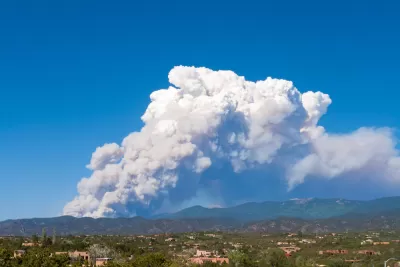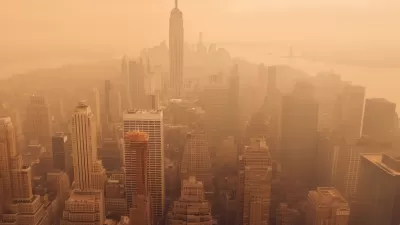Urban water suppliers have had to learn quickly that fire ecology is a major concern in maintaining a secure water supply system.

Jasques Leslie begins this story about the connections between watershed and fire protection with an anecdote from the 2011 Las Conchas Fire in New Mexico, which tripled the size of the previously largest wildfire in state history.
"But the fire’s full impact didn’t register until nearly two months later, when a thunderstorm in the Jemez Mountains washed tons of ash and debris into the Rio Grande River, the water source for half of New Mexico’s population and for a major agricultural area. Only an inch of rain fell, but the debris flows the storm generated turned the river black and dumped ash, sediment, and tree and shrub remnants into a major reservoir, requiring a costly cleanup."
According to Leslie, New Mexico is far from alone in learning this lesson: "megafires in similarly dry and overgrown watersheds have ended up contaminating downstream water supplies in numerous areas throughout the western United States, including Phoenix; Denver; Flagstaff, Arizona; and Fort Collins, Colorado. Downstream water managers serving millions of urban residents have learned that the security of their water supplies is tied to the health of upland watersheds that may be hundreds of miles away."
Now, the safety of the water supply is an outcome of for management—just as historic droughts and insect infestations have required completely new approaches to forest management.
Turning attention back to New Mexico after the Las Conchas Fire, residents in the Rio Grande watershed worked with the The Nature Conservancy to establish the Rio Grande Water Fund. That public-private partnership comprises 73 contributing members, including "government agencies at all levels, foundations and other NGOs, local water utilities, and local businesses and residents."
"Together they raised enough money for a 20-year program to restore 600,000 forest acres — enough to support the resilience of the entire central and northern New Mexico portion of the Rio Grande watershed. They have already restored 108,000 acres, and are racing to complete the job before another megafire occurs," according to Leslie.
FULL STORY: For a Warming World, A New Strategy for Protecting Watersheds

Planetizen Federal Action Tracker
A weekly monitor of how Trump’s orders and actions are impacting planners and planning in America.

Maui's Vacation Rental Debate Turns Ugly
Verbal attacks, misinformation campaigns and fistfights plague a high-stakes debate to convert thousands of vacation rentals into long-term housing.

San Francisco Suspends Traffic Calming Amidst Record Deaths
Citing “a challenging fiscal landscape,” the city will cease the program on the heels of 42 traffic deaths, including 24 pedestrians.

Defunct Pittsburgh Power Plant to Become Residential Tower
A decommissioned steam heat plant will be redeveloped into almost 100 affordable housing units.

Trump Prompts Restructuring of Transportation Research Board in “Unprecedented Overreach”
The TRB has eliminated more than half of its committees including those focused on climate, equity, and cities.

Amtrak Rolls Out New Orleans to Alabama “Mardi Gras” Train
The new service will operate morning and evening departures between Mobile and New Orleans.
Urban Design for Planners 1: Software Tools
This six-course series explores essential urban design concepts using open source software and equips planners with the tools they need to participate fully in the urban design process.
Planning for Universal Design
Learn the tools for implementing Universal Design in planning regulations.
Heyer Gruel & Associates PA
JM Goldson LLC
Custer County Colorado
City of Camden Redevelopment Agency
City of Astoria
Transportation Research & Education Center (TREC) at Portland State University
Jefferson Parish Government
Camden Redevelopment Agency
City of Claremont





























